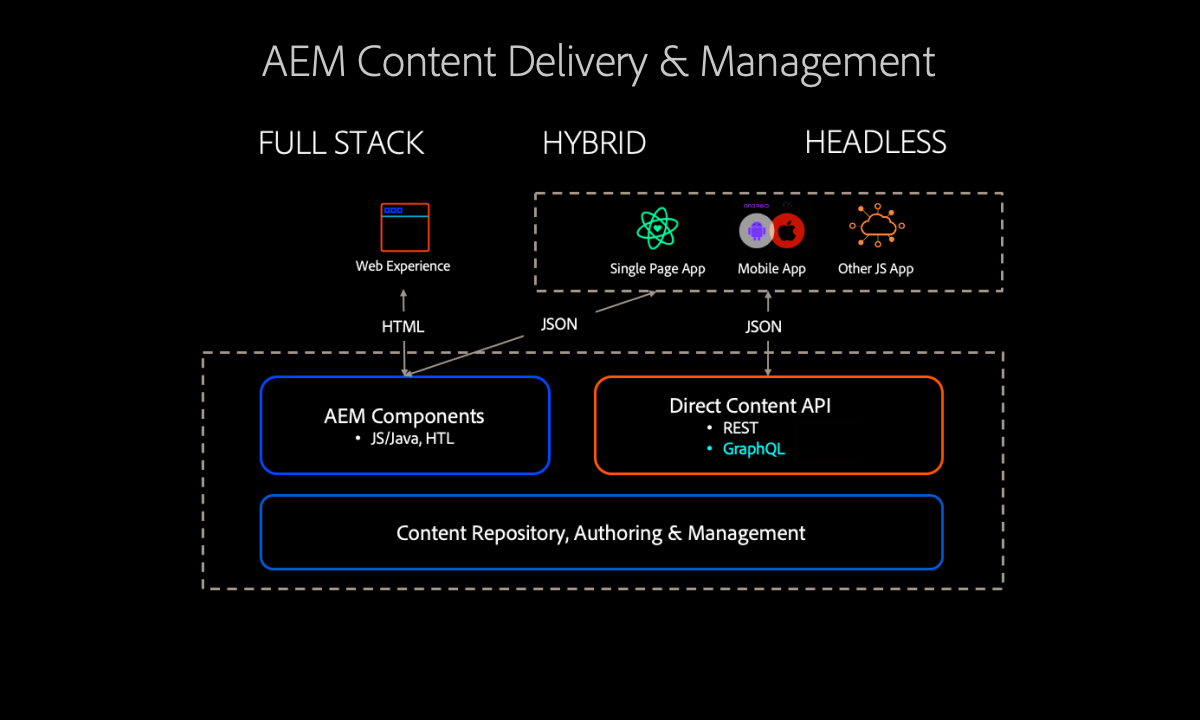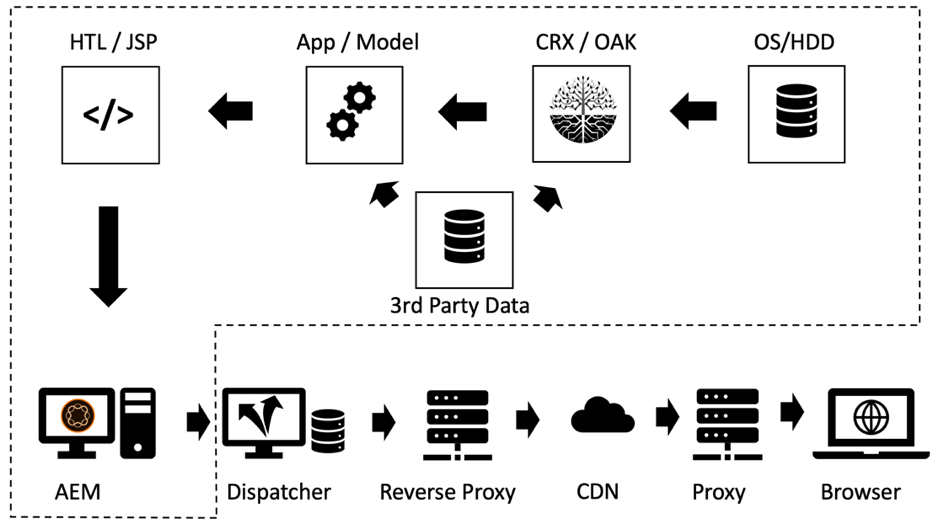In today’s rapidly evolving digital landscape, organizations are seeking ways to deliver content seamlessly across various channels and touchpoints. One approach that has gained significant attention is Headless AEM. In this article, we will explore the concept of Headless AEM, its benefits, architecture, implementation considerations, real-world examples, and its importance in modern digital experiences.

Benefits of Headless AEM
Flexibility for Dynamic Content Delivery
Headless AEM offers organizations the flexibility to deliver content in a decoupled manner, separating the content management system (CMS) from the presentation layer. This decoupling allows for more dynamic and flexible content delivery, enabling organizations to adapt quickly to changing technologies and user demands. By leveraging Headless AEM, businesses can easily deliver content to a variety of platforms, devices, and channels.
Scalability for Enhanced User Experiences
Another significant advantage of Headless AEM is scalability. With the ability to manage content separately from the front-end delivery system, organizations can efficiently scale their content delivery to handle increasing user demands. This scalability ensures a consistent and high-quality user experience, regardless of the volume of content or user traffic.
Ease of Integration for Seamless Workflows
Headless AEM provides seamless integration capabilities, allowing organizations to connect their content management system with other tools and technologies. By integrating with other systems, such as customer relationship management (CRM) or marketing automation platforms, businesses can streamline their workflows and deliver personalized content to enhance user engagement.
Improved Developer Experience
Headless AEM also offers developers a more enjoyable and efficient development experience. By decoupling the CMS from the presentation layer, developers have the freedom to choose their preferred front-end frameworks and technologies. This flexibility empowers developers to work with the tools they are most comfortable with, resulting in faster development cycles and increased productivity.
Understanding the Architecture of Headless AEM
To fully grasp the capabilities and functioning of Headless AEM, it is important to delve into its underlying architecture. Headless AEM comprises three core components: the Content Repository, APIs, and Front-end Delivery Systems. Let’s explore each of these components in detail.
Content Repository
The Content Repository serves as the backbone of Headless AEM, providing a centralized and structured storage system for content assets. It acts as a secure and scalable repository for various types of content, including text, images, videos, and documents. The Content Repository in Headless AEM is based on industry-standard content repository technology, such as the Java Content Repository (JCR) or the Content Services Specification for Java (JSR-283).
The Content Repository in Headless AEM offers several key features:
- Content Modeling: It enables organizations to define and structure their content in a hierarchical manner using a schema or a content model. This structured approach ensures consistency and allows for efficient content management.
- Versioning and Version Control: The Content Repository maintains a version history of content assets, allowing organizations to track changes, revert to previous versions, and implement robust version control mechanisms.
- Workflow and Collaboration: Headless AEM provides workflow capabilities within the Content Repository, enabling organizations to define approval processes, review cycles, and collaboration workflows to streamline content creation, editing, and publishing.
- Metadata Management: The Content Repository allows for the addition of metadata to content assets, providing additional context and enhancing searchability and discoverability.
APIs
APIs play a crucial role in Headless AEM, serving as the bridge between the Content Repository and the Front-end Delivery Systems. These well-defined interfaces allow developers to retrieve content from the repository and manipulate it according to their specific requirements. APIs provide the necessary flexibility and control over content delivery, enabling developers to build dynamic and interactive user experiences.
Headless AEM exposes a set of APIs that facilitate content retrieval, modification, and management. Some key APIs include:
- Content API: This API allows developers to retrieve content from the Content Repository based on specific criteria, such as content type, metadata, or hierarchical structure. It provides a structured and efficient way to access content assets.
- Asset API: The Asset API enables developers to interact with digital assets stored in the Content Repository, such as images, videos, or documents. It offers functionalities for asset upload, retrieval, transformation, and metadata management.
- Query API: The Query API empowers developers to perform advanced searches and queries on the Content Repository. It supports various querying mechanisms, including full-text search, property-based search, and structured query language (SQL)-like queries.
- Workflow API: Headless AEM exposes a Workflow API that allows developers to interact with workflows and automation processes within the Content Repository. It enables the initiation, management, and monitoring of content-related workflows.
Front-end Delivery Systems
Front-end Delivery Systems are responsible for rendering and presenting the content to end-users. With Headless AEM, organizations have the freedom to choose their preferred front-end frameworks, such as React, Angular, or Vue.js. These frameworks consume content through the exposed APIs and generate the user interface, providing a seamless and engaging experience for the audience.
Front-end Delivery Systems in Headless AEM offer the following capabilities:
- Content Consumption: The Front-end Delivery Systems consume content from the Content Repository via APIs and leverage it to create dynamic and personalized user experiences. They handle content retrieval, caching, and rendering based on specific business logic and user interactions.
- Templating and Presentation Logic: Front-end frameworks in Headless AEM provide powerful templating capabilities, allowing developers to define how the retrieved content is structured and presented. They enable the separation of content and presentation logic, facilitating flexibility and reusability.
- Component-based Development: Headless AEM promotes a component-based approach to development, where reusable components are built and composed to create the user interface. Front-end frameworks facilitate the creation and management of these components, ensuring modularity and scalability.
- Integration with Third-party Services: Front-end Delivery Systems can seamlessly integrate with various third-party services and tools, such as analytics platforms, personalization engines, or social media platforms. This integration enables organizations to enhance the user experience and gather valuable insights.
Use Cases for Headless AEM
Headless AEM finds its applicability in various use cases where flexible content delivery is crucial. Let’s explore some of the prominent use cases:
Mobile Apps
In the mobile-first era, delivering content to mobile applications is paramount. Headless AEM allows organizations to efficiently manage and deliver content to mobile apps through APIs. This enables businesses to provide personalized and context-aware content, enhancing the user experience on mobile devices.
Single-Page Applications (SPAs)
Single-Page Applications have gained popularity due to their seamless and responsive user interfaces. With Headless AEM, organizations can create SPAs using their preferred front-end frameworks while leveraging the content management capabilities of AEM. This combination enables the delivery of dynamic and interactive content to users, resulting in engaging web experiences.
Internet of Things (IoT) Devices
As the IoT ecosystem continues to expand, Headless AEM offers a powerful solution for content delivery to IoT devices. By leveraging APIs, organizations can distribute content to IoT devices and provide real-time information and experiences. Whether it’s delivering content to smart displays, wearables, or connected appliances, Headless AEM ensures consistent and context-aware content delivery.
Implementation Considerations
Implementing Headless AEM requires careful consideration of various factors to ensure a successful implementation. Let’s explore some crucial aspects that organizations should take into account:
API Design
Designing efficient and well-documented APIs is essential for seamless content delivery. Organizations should carefully plan and define their APIs, considering factors such as data structure, authentication mechanisms, error handling, and versioning. A well-designed API ensures smooth communication between the content repository and front-end systems.
Security
As with any digital solution, security should be a top priority when implementing Headless AEM. Organizations must enforce strong authentication and authorization mechanisms to protect sensitive content and prevent unauthorized access. Additionally, data privacy and compliance with relevant regulations should be thoroughly addressed to maintain the trust of users and customers.
Performance
Optimizing performance is crucial for delivering a fast and responsive user experience. Implementing caching strategies, optimizing API response times, and leveraging content delivery networks (CDNs) can significantly improve performance. Organizations should analyze and optimize the entire content delivery pipeline to ensure smooth and efficient content rendering.
Caching Strategies
Caching plays a vital role in Headless AEM implementations. Organizations should carefully consider caching strategies to minimize the load on the content repository and improve response times. Techniques such as content fragment caching, reverse proxy caching, and edge caching can be employed to enhance scalability and overall system performance.

Conclusion
Headless AEM represents a paradigm shift in content management and delivery, empowering organizations to achieve flexibility, scalability, and enhanced user experiences. By decoupling the CMS from the presentation layer, organizations can adapt quickly to changing technologies, deliver personalized content, and provide engaging experiences across various platforms and devices. With careful implementation considerations and real-world examples to draw inspiration from, organizations can leverage Headless AEM to unlock the full potential of their content delivery strategies.

I’m Kirill Efimov, an experienced AEM developer with over 10 years of experience in Java and web development. I’m skilled in developing AEM components, templates, workflows, and integrations with other systems, and I’m passionate about delivering high-quality solutions to my clients.
I also believe in knowledge-sharing and staying up-to-date with the latest developments in the industry. Through blog posts, tutorials, and speaking engagements, I’m committed to contributing to the AEM community and helping others overcome the challenges they may face in their AEM projects.